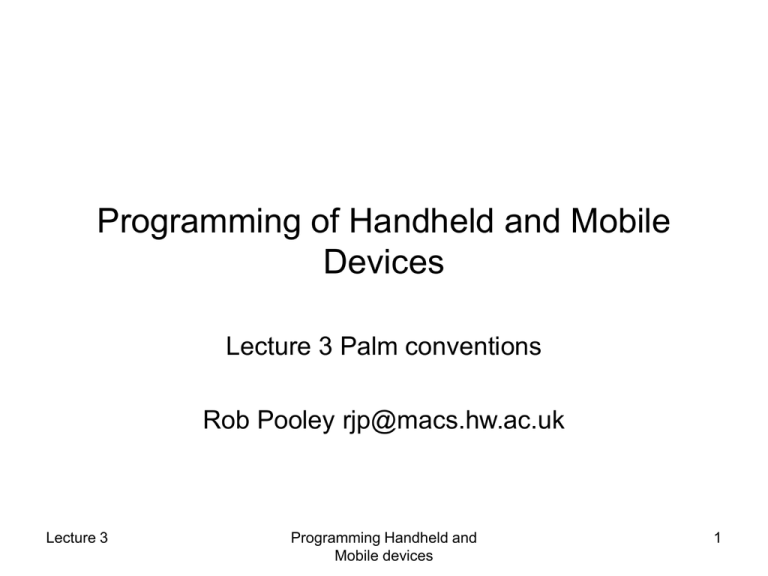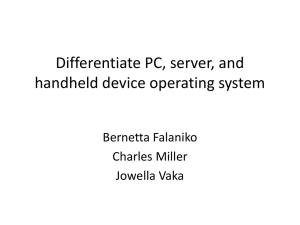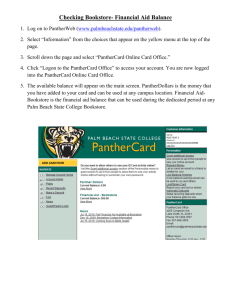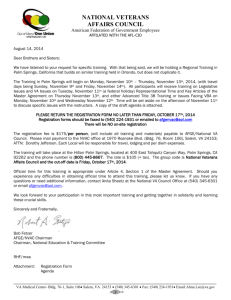Programming of Handheld and Mobile Devices
advertisement

Programming of Handheld and Mobile
Devices
Lecture 3 Palm conventions
Rob Pooley rjp@macs.hw.ac.uk
Lecture 3
Programming Handheld and
Mobile devices
1
Programming conventions
• Each application has a PilotMain()
function that is equivalent to main
in C programs.
• All applications should use the
memory and data management
facilities provided by the system.
• Palm OS applications are largely
event-driven and so contain an
event loop; however, this event
loop is only started in response
to the normal launch. Your
application may perform work
outside the event loop in
response to other launch codes.
• Applications employ operating
system services by calling Palm
OS functions. Palm OS consists of
several “managers,” which are
groups of functions that work
together to implement a feature.
• Most Palm OS applications contain
a user interface made up of
forms, which are analogous to
windows in a desktop application.
Lecture 3
Managers are available to, for
example, generate sounds, send
alarms, perform network
communication, and beam
information through an infrared
port.
Programming Handheld and
Mobile devices
2
API Naming Conventions
• Functions start with a capital letter.
• All functions belonging to a particular
manager start with a short prefix, such
as “Ctl” for control functions or “Ftr” for
functions that are part of the Feature
Manager.
• Events and other constants start with a
lowercase letter.
• Structure elements start with a lowercase
letter.
• Typedefs start with a capital letter and
end with “Type” (for example,
DateFormatType, found in
DateTime.h).
• Notifications start with a prefix (most
often, “sys”) followed by the word
“Notify.” For example,
sysNotifyAppLaunchingEvent.
• Launch codes have a prefix followed by
“LaunchCmd,” as in
sysAppLaunchCmdNormalLaunch.
Lecture 3
• Members of an enumerated type start
with a lowercase prefix
followed by a name starting with a capital
letter, as follows:
enum formObjects {
frmFieldObj,
frmControlObj,
frmListObj,
frmTableObj,
frmBitmapObj,
frmLineObj,
frmFrameObj,
frmRectangleObj,
frmLabelObj,
frmTitleObj,
frmPopupObj,
frmGraffitiStateObj,
frmGadgetObj};
typedef enum formObjects
FormObjectKind;
Programming Handheld and
Mobile devices
3
Compatibility with Palm OS
Your application will integrate well with others if
you follow
the guidelines in this section. Integrate with the
system software as
follows:
• Handle sysAppLaunchCmdNormalLaunch
• Handle or ignore other application launch
codes as appropriate. For more information,
see Chapter 2,
“Application Start and Stop,” on page 21.
• Be sure your application uses the system
preferences for numeric formats, date, time,
and start day of week. See Chapter 3,
“Preferences,” on page 37 of Exploring Palm
OS: System Management for instructions on
how to do so.
• Don’t obscure shift indicators.
In addition, follow these rules:
• Store state information in the application
preferences database, not in the application
record database.
• If your application uses the serial port, be sure
to close the port when you no longer need it
so that the HotSync application can use it.
Lecture 3
• Ensure that your application properly handles
the global find. Generally, searches and
sorts aren’t case sensitive.
• If your application supports private records, be
sure they are unavailable to the global find
when they should be hidden.
• Integrate with the Launcher application by
providing an application name, two
application icons, and a version string
• Follow the guidelines detailed in Exploring
Palm OS: User Interface Guidelines.
• Ensure that your application properly handles
system messages during and after
synchronization.
• Ensure that protected records and masked
record contents are not displayed if the user
has so indicated.
• Ensure that your application uses a consistent
default state when the user enters it:
• If your application uses sounds, be sure it uses
the Warning and Confirmation sounds
properly.
Programming Handheld and
Mobile devices
4
Writing Robust Code
• Check assumptions.
You can write defensive code by
making frequent use of the
DbgOnlyFatalErrorIf() macro,
which enables your debug builds
to check assumptions. Many bugs
are caught in this way, and these
“extra” calls don’t weigh down
your shipping application.
You can keep more important checks
in the release builds by using the
ErrFatalErrorIf() function.
Lecture 3
• Avoid continual polling.
To conserve the battery, avoid
continual polling. If appropriate,
take advantage of the keyUpEvent
or the facilities for performing
event-based pen tracking to avoid
polling altogether.
• Avoid reading and writing to NULL
(or low memory). In Palm OS
Cobalt reading and writing to
NULL will cause your application
to crash. When calling functions
that allocate memory, at least
make sure that the pointers they
return are non-NULL.
Programming Handheld and
Mobile devices
5
• Check result codes when allocating
memory. Because various Palm
Powered devices have larger or
smaller amounts of available
memory, it is always a good idea
to check result codes carefully
when allocating memory.
• Avoid making assumptions about
the screen. The size and shape of
the screen, the screen buffer, and
the number of pixels per bit aren’t
set in stone—they vary from one
Palm Powered device to another.
Don’t hack around the windowing
and drawing functions; the
functions provided are optimized
to make best use of the underlying
hardware and to allow multiple
applications and system services
to share it.
Lecture 3
• Built-in applications can change.
The format and size of the
preferences (and data) for the
built-in applications is subject to
change. Write your code
defensively, and consider
disabling your application if it is
run on an untested version of the
OS.
Programming Handheld and
Mobile devices
6
Uniquely Identifying Your Palm OS Application
• Each Palm OS application—in fact, each Palm OS
database—is uniquely identified by a combination of its
name and a four-byte creator ID.
• Each database on the Palm Powered device has a type
as well as a creator ID. The database type allows
applications and the OS to distinguish among multiple
databases with the same creator ID.
• Types and creator IDs are case-sensitive and are
composed of four ASCII characters in the range 32-126
(decimal). Types and creator IDs consisting of all
lowercase letters are reserved for use by PalmSource,
so any type or creator ID that you choose must contain
at least one uppercase letter, digit, or symbol
Lecture 3
Programming Handheld and
Mobile devices
7
Programming Tools
• Several tools are available that help you build, test, and
debug Palm OS applications:
• see http://www.palmos.com/dev/tools/ for information
about your development language and tool options.
• The book Palm OS Programming Development Tools
Guide describes the PalmSource-provided debugging
tools available on your development platform.
Lecture 3
Programming Handheld and
Mobile devices
8
Launch Codes and Launching an
Application
•
•
An application launches when its
PilotMain() function is called with a
launch code. Launch codes are a
means of communication between
the Palm OS and the application
or between two applications.
Other launch codes specify that
the application should perform
some action but not necessarily
become the current application
(the application the user sees).
Lecture 3
•
Each launch code may be
accompanied by two types of
information:
– A parameter block, a pointer
to a launch-code-specific
structure that contains several
parameters. These
parameters contain
information necessary to
handle the associated launch
code.
– Launch flags indicate how the
application should behave. For
example, a flag could be used
to specify whether the
application should display UI
or not.
Programming Handheld and
Mobile devices
9
Resources and make
• As well as writing a program for your application the
Palm C/C++ IDE requires
– A resource file, which specifies information about,
among other things, forms and buttons
– A make file which controls the use of libraries,
#include files etc.
• In the next lecture we will look at a very simple
application and all the information needed to make it
work
• We will then look at the use of the IDE to create an
application and how to test this
Lecture 3
Programming Handheld and
Mobile devices
10





